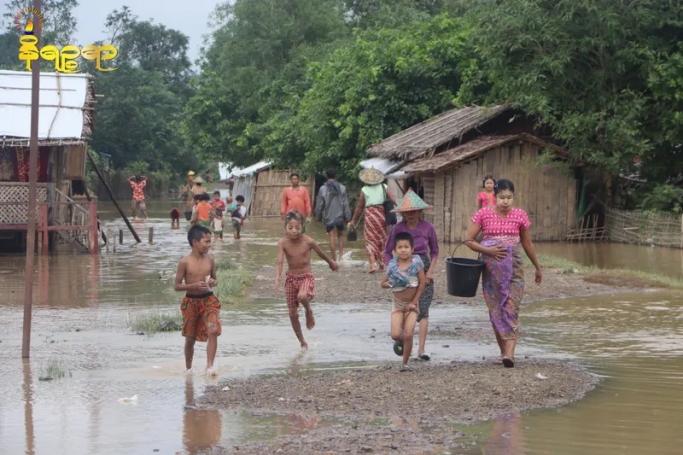From the beginning of August, prolonged monsoon rainfall and a rise in river levels have resulted in the flooding of internally displaced people’s (IDP) camps located in Kyauktaw and Mrauk-U Townships in Rakhine State in Myanmar.
IDP camp officials have reported that the residents of several IDP camps in those townships were forced to evacuate as a result of the floods. These displaced individuals are now experiencing shortages of food and facing health challenges.
The water levels in the Mya Tan Saung IDPs Camp in Mrauk-U Township subsided on 10 August, allowing the displaced individuals to return to their homes. However, there are reports indicating that they are facing challenges with their living conditions and experiencing difficulties in accessing food.
“Approximately 40 houses were destroyed as the water receded. Among them, one house was completely demolished while 31 others suffered partial damage. Thanks to donations from relevant volunteer groups, there is enough food to sustain the camp residents for around 10 days. However, the daily living conditions continue to pose challenges for the displaced individuals,” said Mya Tan Saung Sayardaw, in charge of Mya Tan Saung IDPs camp in Mrauk-U Township.
It is reported that relevant volunteer organizations are providing healthcare services to at least 40 individuals who are currently sick in the Mya Tan Saung IDPs Camp. The camp is currently home to 1,175 IDPs.
“Several people in the camp are unwell. Approximately 40 people of all ages are currently experiencing illness,” Mya Tan Saung Sayardaw said.
Mosquitoes breeding in ponds formed after water entered the Tain Nyo IDPs camp in Mrauk-U Township is causing concern for the camp's population of over two thousand people, as there is an increased risk of dengue fever and malaria, according to an official of Tain Nyo IDPs camp.
“I am also concerned about the current living conditions, including the presence of stagnant water and mosquito breeding after the camp was flooded. The muddy road is making travel difficult, and there is
growing worry about the spread of diseases such as dengue fever and malaria. Previously, the camp did not experience such health issues, but with the water submerging the area, mosquito breeding has increased, resulting in a rise in mosquito bites,” Ko Kyaw Htin, the official of Tain Nyo IDPs camp told Mizzima.
According to residents of Kyauktaw, the Nyaung Chaung IDPs Camp in Kyauktaw township, housing over 4,000 IDPs, has also been flooded as a result of the rising river water and prolonged rainfall. This unfortunate situation has led to significant health and food-related challenges for the camp.
The United League of Arakan (ULA) has reported that heavy rains in Rakhine State had caused floods in several townships, including Buthidaung, Rathedaung, Ponnagyun, Kyauktaw, Min Bya, Mrauk-U, and Taungup.
According to the ULA, the flooding in Rakhine State has resulted in the unfortunate loss of five men and one woman. Additionally, more than 30,000 houses have been flooded.
Rakhine IDP camps were badly his when Cyclone Mocha hit the state in May. The recent monsoon flooding has compounded the damage caused during that natural disaster.












